In the late Neolithic China, precious stones, brick tea, silk, and cowry shells were used as a medium of exchange. About 4000 years ago, Chinese coins were cast and widely circulated in the Zhou Dynasty . Ever since then, the cast coins became the most common form of ancient Chinese currency. After Qin's unification of the country in 221 BC, the round coin with a central square hole superseded all previous types of cast metal coins. They circulated continuously till the Ming and Qing Dynasties (1368-1911), though the style varied with time. By the Song Dynasty (960-1279) paper notes had appeared and were used in the Yuan, Ming and Qing Dynasties (1279-1911). Silver coins appeared in the Daoguang reign of the Qing Dynasty, and minted silver and copper coins circulated in the Guangxu reign of the Qing Dynasty (1875-1908). The development of monetary system in ancient China has a close connection with the history of Chinese economy and politics.
Different ancient Chinese coins
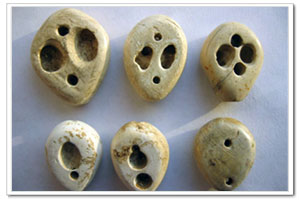 Cowry shells
Cowry shells
Cowry shells were used as the medium of exchange in the late Xia Dynasty (21st century BC). Those from the Shang Dynasty (16th century BC to 11th century BC) usually had teeth on one side and a hole for stringing on the flat polished other side. As natural cowries were limited in quantity, copies made of stone, other seashells, bone and bronze were also in circulation. Bronze replicas of cowries became the first Chinese cast coins.
Weighted metals
Smelted metal pieces without any denomination were used as money in commodity exchanges. They were valued according to the weight and material quality. Gold plates were used in the Chu State during the Warring States period (475- 221 BC).
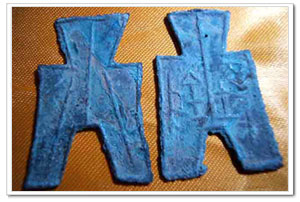 Spade-shaped coins
Spade-shaped coins
Cast coins in the shape of a spade were developed in the early days of metal coin usage, and were still used sporadically until the early part of the Han Dynasty. In the beginning they had a hollow handle, but during the Warring States period (475-221 BC), the handle was solid.
Sword-shaped coins
Sword-shaped coins were a cast coin in a sword shape with a ring at the end of the handle.
Round coins
There are two types of cast round coins in ancient China: one with a round hole in the center like a ring, the other with a square hole in the center.
Minted coins
During the Guangxu reign period (1875-1908) of the Qing Dynasty, western coin minting technology was introduced into China. Zhang Zhidong, the governor-general of Guangdong and Guangxi regions, set up a mint in Guangzhou with some machines brought from Britain and made the first Chinese minted coins-silver and copper dollars-in the fifteenth year of Guangxu’s reign (1889).
Cowry-shaped bronze coins
Cowry-shaped bronze coins were cast in the Chu State during the Warring States period (475-221 BC). They usually had inscriptions of strange characters. One character, often seen, looks like an ant, another one like a monster's face.
Gold coins
The Chu State was the first in ancient China to cast gold coins. Both have the stamped inscription “Ying Cheng.” Ying was the capital of the Chu State, and "Cheng" was read as "Yuan," a metric unit of weight and was also used as the name of the money. So it was called "Yuan Jin" meaning gold coins. They were valued by their weight in circulation.
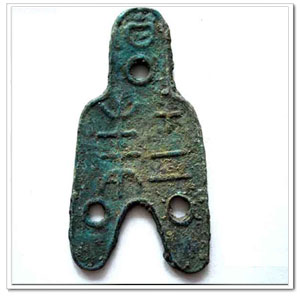 Spade-shaped coin
Spade-shaped coin
Among the spade-shaped coins, there is a rare type that has three round holes. It carries over 20 kinds of inscriptions on its face and a denomination of "Liang" (teal) or "Shi Er Zhu" (12 Zhu) on the back. It is the earliest Chinese coin with a determined denomination.
"Ban Liang" (half teal) coin
The Qin Ban Liang (half teal) coin, is round with a central square hole. It became the national legal currency after the first emperor united the country (221 BC). The denomination Ban Liang, refers to its weight, which equals 7.5 gram.
Wu Zhu coins
Wu Zhu (five Zhu) coins, weighing about 3 gram each, were cast in the Wudi reign period (140-135 BC) of the Han Dynasty. They were continuously used till the Sui Dynasty (581-618).
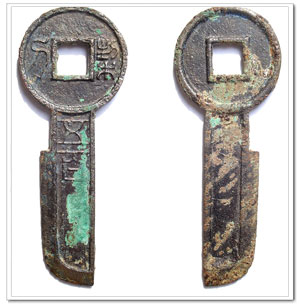 Xin Mang coins
Xin Mang coins
As a result of four reformations of the monetary system by the Xin Mang government (9-23), the Wu Zhu coin system was abolished and a great variety of currency appeared in the country. The newly issued coins were odd-shaped ingots of silver, gold or bronze. The bronze coin inscriptions were especially fine.
Kai Yuan Tong Bao coins
In 621, the 4th year of Tang Emperor, Wude, Kai Yuan Tong Bao coins were formally issued and the former Wu Zhu coin system was abolished. As the major currency of the Tang Dynasty each Kai Yuan Tong Bao coin weighed one-tenth Liang. Tong Bao and Yuan Bao were other coins minted during this period.
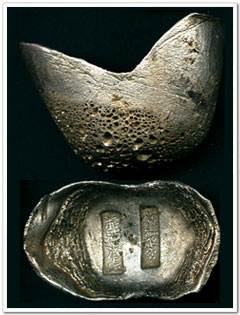 Jiao Zi paper notes
Jiao Zi paper notes
In the early Song Dynasty iron coins were popularly used in Sichuan province. Because they were small in value and heavy to carry, merchants issued a paper note called Jiao Zi, the earliest paper note in the world.
Silver ingots
Since the Tang and Song dynasties (618-1279), silver had been used as money. It was cast in various forms, with ingots being the most common one.

